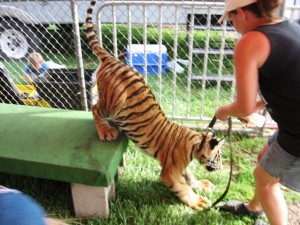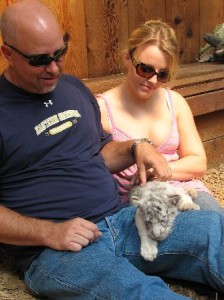Who wouldn’t want a chance to hold and pet a tiger cub? After all they are adorable. The truth is that petting cubs does not benefit tigers, no matter how much the facility attempts to convince you it’s educational and for conservation. It always leads to abuse.
Exhibitors want you to believe that they are helping wild tigers by breeding more, raising money for conservation, and the animals you see now will end up in a good home. These are just some of the lies.

Tigers, like Izzy, that are used for cub petting exhibits usually end up as a pet, in a road side zoo, or euthanized. Most of these tigers live on the road or in substandard conditions and are constantly being handled even after the legal age. Cubs are often torn from their mothers very early on so they can be hand raised by humans. Some older tigers are constantly sedated for “safety”.
Many cities are starting to ban this terrible practice and you can help by just saying NO! Also, by passing the Big Cats and Public Safety Act, we can help end private possession of tigers.
Fast Facts About Cub Petting:
- Cubs are only legally allowed to be handled by the public from 8-12 weeks of age.
- Constant camera flashes often cause early cataracts in developing eyes of cubs.

- Since the public is handling cubs, they are exposed to many diseases and bacteria. Often times cubs have diarrhea and other illnesses.
- Young tigers need to sleep during the day but are kept awake by constant handling.
- Exhibitors will blow in the tiger’s face to “calm” them.
- Exhibitors will also dangle them by holding underneath their front arms and bounce them up and down to “reset” the cub
- Since cubs become too big so fast, they must constantly breed more tigers to use. This does NOT help conservation but fuels the overpopulation of captive tigers. Learn more about The Big Cat Crisis.
- Lions in South Africa are bred for cub petting and grow up to be in a canned lion hunt.
- Cub abuse is not conservation or educational.
- Once tigers are too big to be used for an exhibit they may sell the tiger to the black market for parts.
